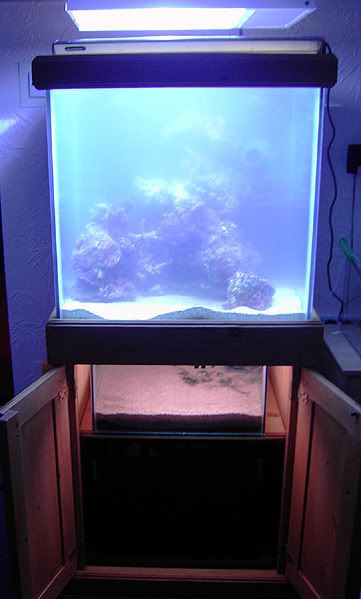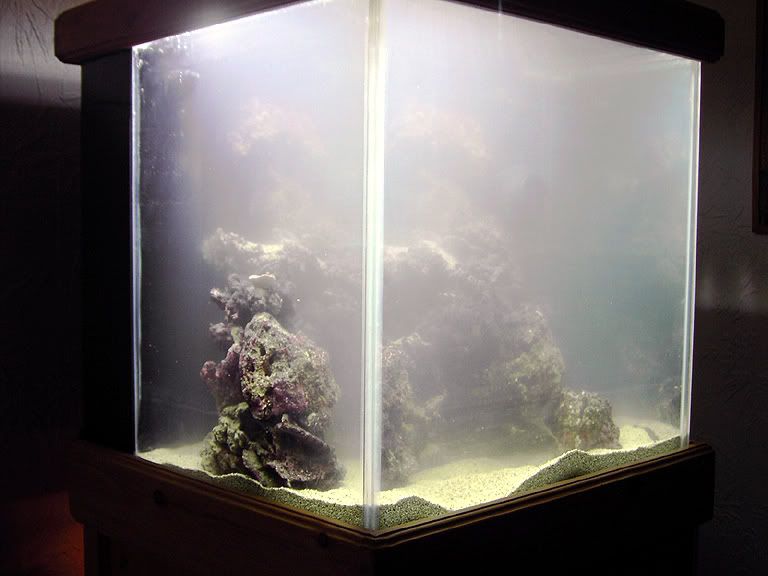Monday, April 24, 2006
Meet .....

Male and female Synchiropus stellatus (Starry dragonnettes)

Lybia tessellata (pom pom crab)

Purple Gorg

Baby suncoral

Montipora digitata

Plating hydnopora


? Nassarius sp. snail/?babylonia sp. snial (sold as Orange spot snail)

Large Hawaiian feather duster
Cube Tank Spec:-
------------------------------------------
(*Note; volumes are before displacement)
Display tank size:- 226lts (50 UK gal) - Partitioned with a false weir at back of tank
Sump size:- 114lts (25 UK gal) - divided into mechanical filtration bays, bubble trap bays, mechanical equipment bays and there is a 'cryptic area' (an attempt to replicate the benthic zone of the ocean)
Refugium size:- 40 lts (8 UK gals) - miracle mud base, with 3" DSB and macro algaes.
Total system capacity = 334lts (83 UK gals)
--------------
Filtration:- Approx 30kg Live RockRefugium with mud and macro algae system TMC V2Skim 600 Skimmer, Cryptic area filter feeders
--------------
Water circulation:- 3500lt/hr OR pump returned to tank via a SCWD and 2 rotating nozzles4400lt/hr Seio super pumpFuture scope for a flush/surge device
Total turn over of water = 7900lts/hr (or main tank water is turned over 35 times every hour)
--------------
Main tank lighting:- 1 x 250W Metal Halide light (20,000K spectrum)1 x 55W T5 compact actinic2 x cold cathode tube black UV lights
Total main tank light = 6.1WPG
--------------
Refugium lighting :- 1 x 18W T8 bulb (reverse photoperiod)
--------------
Stock:- - Softies, LPS future scope for SPS
--------------
S.G. = 1.026
Friday, April 21, 2006
Aquascaping and acclimatisation
Aquascaping
Because the tank is viewable from 3 side (each pane about the same size) i felt it necessary to aquascape in 3 dimensions (i.e. not just thinking about what it would look like from the front). I've always had the idea of a central island look, but the details i was unsure about. I've looked for naturally occuring reef mound pictures and thought about copying that, but i have been influenced by Takeshi Amano who tends to aquascape to recreate things of beauty above water (i.e. a lush green field). I decided to try and aquascape a secluded bay, with rocky overhangs, and surrounding beach, i'm not sure if i have achieved it or not, or whether it will stay that shape, but it will do me for now. I also created a raised platform with the rock and filled it with sand (doesn't blow about in the flow!) - this was a functional thing to act as maybe a 'clam stage' or some where to embedd LPS who prefer to be in the sand, but also need lots of light (torch coral is in there at the moment)
Some pics of Zakynthos (Greece) that made a lasting impression from when i visited in 1999

Keri

Navagio wreck - Smugglers cove
It was rather strange, although i had an idea of what i wanted the aquascape to look like, i was bound by live rock shape and size. As it turned out, the 2nd hand rock i picked up, almost fell into place, creating a scape better than i had planned for!


Acclimatising
I needed to shift the stock from my nano tank into the cube. This was a sloooowww, drawn out, but necessary process, i dripped the water out of the cube into acclimatising buckets for 60-90mins depending on what i was acclimatising.
I started with the more hardy corals, adding Xenia and some zoanthids and monitoring their response to the new conditions. Once they appeared to be happy, i started moving clean up crew and monitoring their response. Later i acclimatised the more potent corals such as the plate and torch. Finally I acclimatised my fish. For those of you who know nothing about my nano ....... meet Puff and Krusty! - Puff (the magic dragonnette) is a scooter blenny with attitude and Krusty (the clownfish) is a special little false perc, who was chosen because he looked little different from the rest of is clown buddies on purchase.
Whilst transferring stock, random frags of live rock were added to the system, either to the aquascape, to the fuge or to the cryptic area. I also took this opportunity to transfer my live sand bed to the cube and the fuge.
My corals don't like me anymore, they were looking as good as they ever have in the nano, but after shifting them they are all closed and spewing mucus out.
'Rock in' ...................... \m/

Rock was whisked back within 20-30 mins of being removed to reduce the likely hood of a cycle.

I put the rock straight in the tank, without aquascaping. Waited a while to ensure it was fully saturated, took it back out and began the aquascaping process


Tuesday, April 18, 2006
Salty Dog
I filled her up with 200 litres of saltwater today \0/ just another 200 to go to fill the rest of the tank and the sump .....
Not so Low Bays, moreso 'HiLo Bays' :)
After measuring up, and going into the loft, it was apparent that the hooks would penetrate the ceiling and only be suspended by plasterboard. I decided to pull back the insulation and add some more joists to support the weight.

With that all fine and dandy, it was time to hang 'em and switch them on. The lights come with a hanging kit, which is basically metal chains and hooks, which look bit unsightly, also not very functional if you want to do maintainance. Therefore i decided to get some 'HiLo' hanging basket belts. Basically they can be adjusted to any height, and lock into place with a seatbelt type lock (i.e. when you jerk it, it locks it into place), functional and more aesthetically pleasing.
Here are the results;-


Rest in Peace
Here are the results, this is where the tank will live for the forseable future.


Monday, April 10, 2006
Freshwater test run
I did one tonight and it was pretty successful. There are some minor issues that need resolving but apart from that i am really quite happy with the outcome
This shows the kind of circulation i am getting

This is a video of the surface agitation
This video show the hydo flo nozzles in action, They work on alternative cycles due to the action of the SCWD
This shows the fuge being fed from the second overflow and draining at the back right side

Pipe work arrived \0/
First I drilled 2 holes in the false back to fit the Hydor rotating nozzles through.

The SCWD was then piped into the Hydor rotating nozzles

Next the back piping was solvent welded in place The pipe on the left is the primary overflow, the middle pipe is the return from the OR3500, the pipe on the right is the secondary overflow, which is also used to feed the fuge with a slow gentle trickle
The pipe on the left is the primary overflow, the middle pipe is the return from the OR3500, the pipe on the right is the secondary overflow, which is also used to feed the fuge with a slow gentle trickle
















